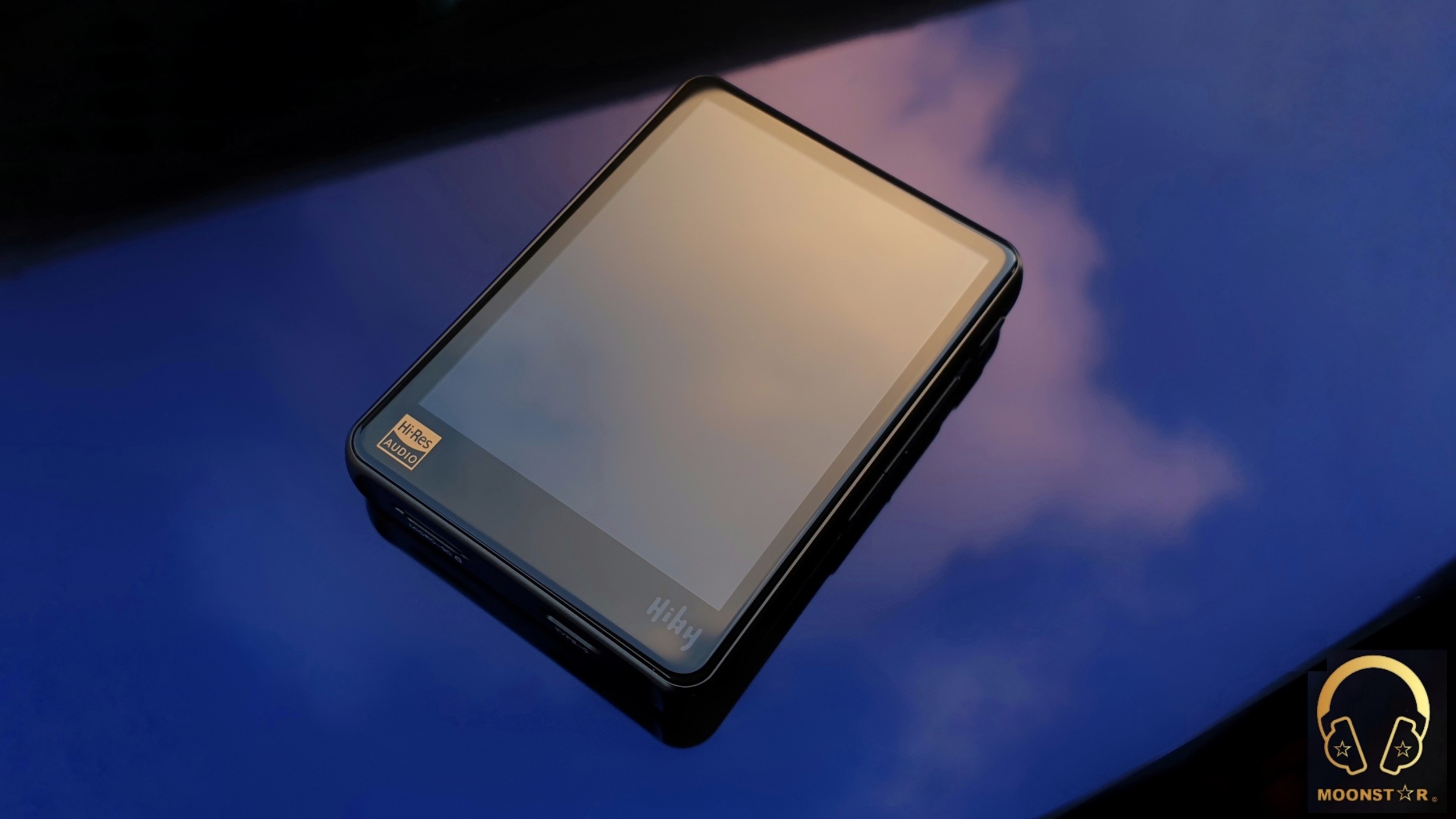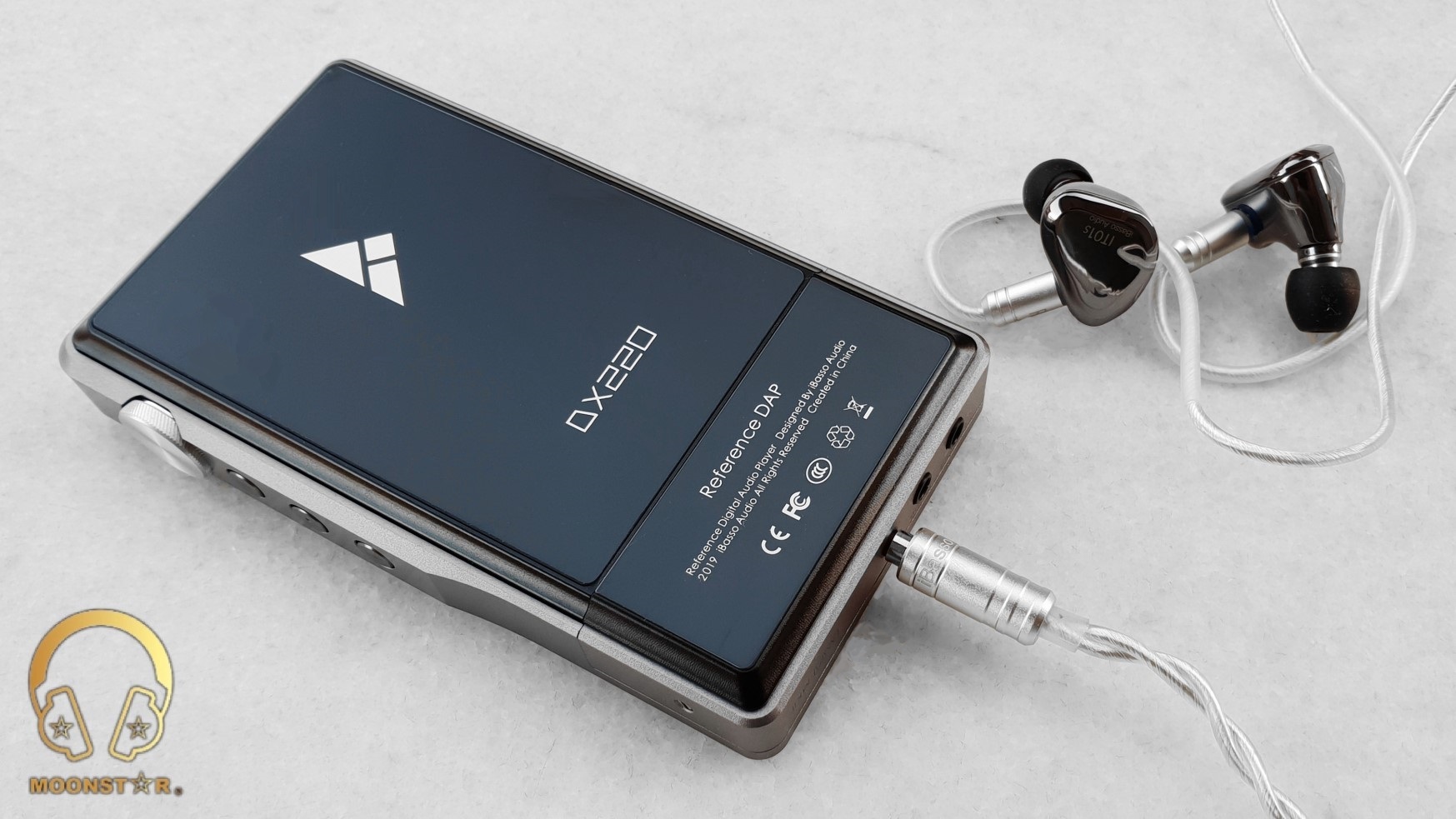iBasso DX300 Reference DAP Review
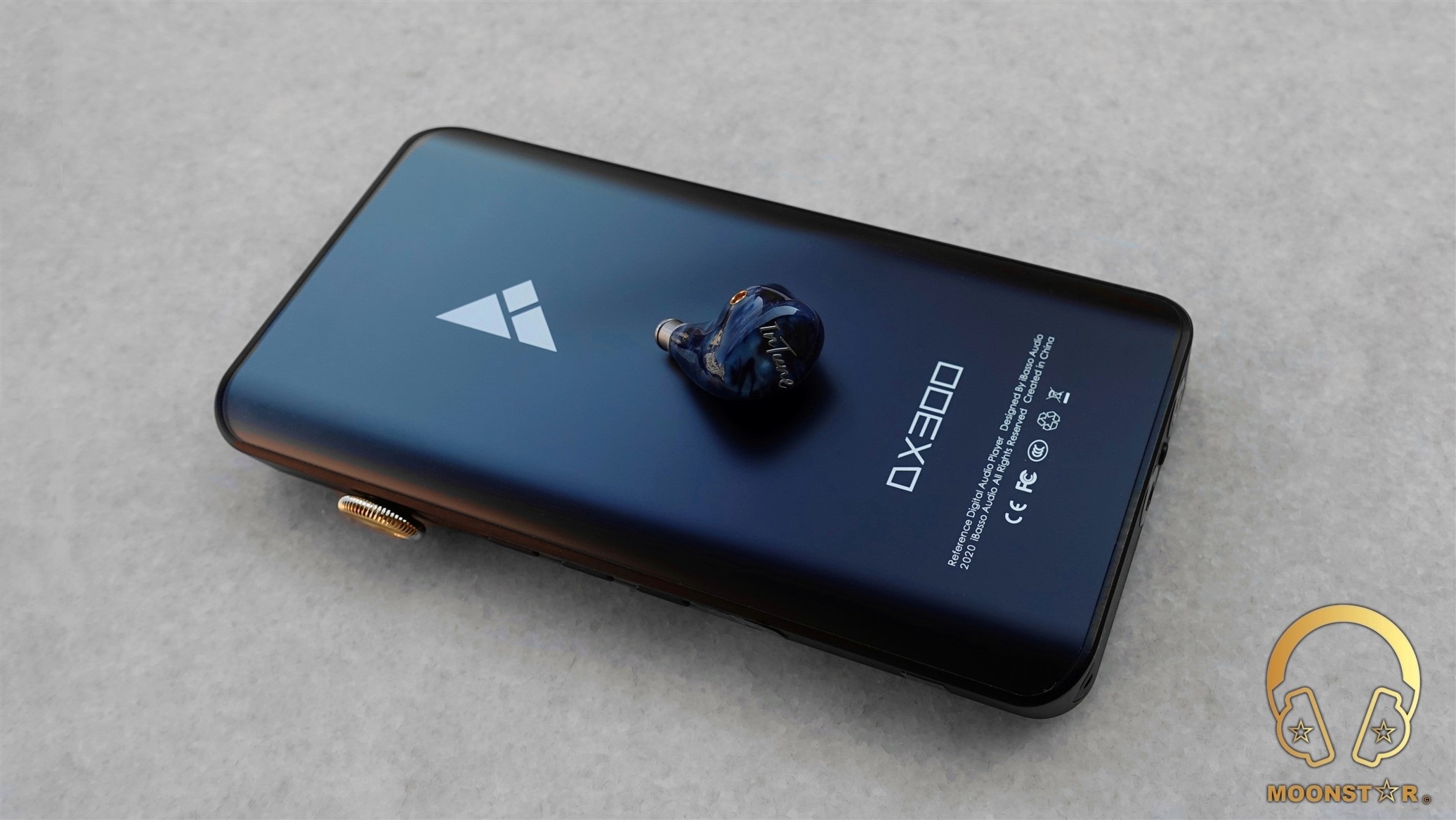
iBasso DX300 Digital Audio Player Review
Introduction:
iBasso is a Chinese company that is specialized in the production, development & designing of Portable Audio products such like Digital Audio Players (DAP), Portable Amplifiers and In-Ear Monitors/Headphones.
The iBasso DX300 is the latest Portable Digital Audio Player (DAP) of the company that features new hardware and design elements like the 4x Cirrus CS43198 DAC chips, 8-core Qualcomm Snapdragon 660 SoC, 6GB RAM & 128GB Rom, FPGA Master Technology, Patented Dual Battery Supply Structure, 6.5” 2340×1080 screen and many more compared to past models like the DX150, DX200 and DX220.
- Official Webpage: http://www.ibasso.com/

Disclaimer:
I would like to thank iBasso for providing me the DX300 as review sample. I am not affiliated with iBasso beyond this review and these words reflect my true and unaltered opinions about the product!
Price & Availability:
The DX300 is the latest Digital Audio Player of the company that was released in the High End category. The current price of the DX300 is $1199.00 USD. More information’s can be found under the link bellow;
Package and Accessories:
The DX300 came in a dark blue box that has a nicely soft textured surface with the iBasso brand logo on the top. This box has a cardboard sleeve in grey color with the iBasso DX300 Reference DAP branding on the top.

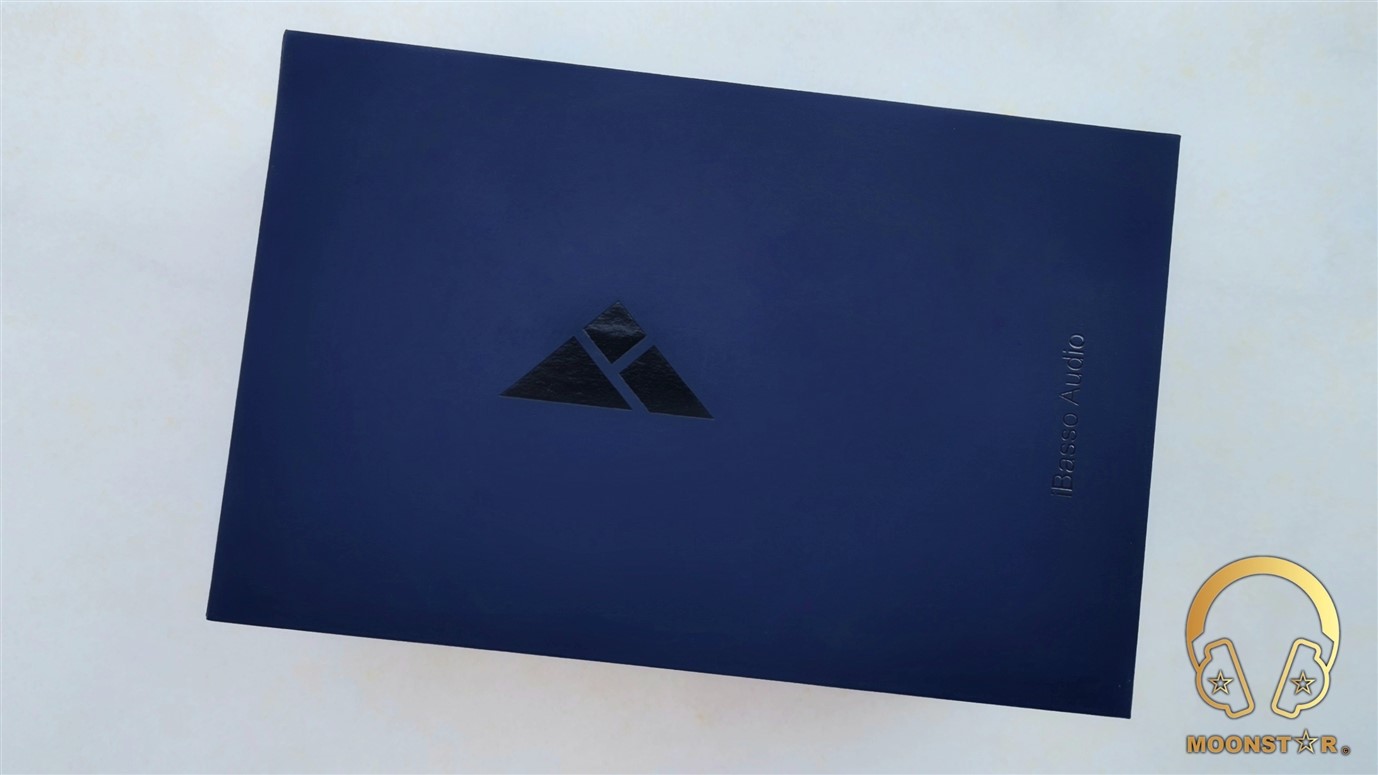
The DX300 comes with a rich accessories package that includes the following items;
- 1 x iBasso DX300 Reference DAP
- 4 x Protective films
- 1 x Leather case
- 1 x USB Type-C Charging/Data Cable
- 1 x Coaxial (SPDIF) Cable
- 1 x Burn-In Cable
- 1 x User Manual
- 1 x Warranty Card

The leather case that is in blue color looks pretty nice and shows a high quality workmanship. The inner surface of the case is silky soft with some nice iBasso patterns.

However, you need to be a bit careful, beause the surface coating makes the device quite susceptible to slipping.



The protective films, burn-in and coaxial (SPDIF) cables are some nice addition.

Design, Buttons and Build Quality:
The iBasso DX300 is a great looking DAP that has a quite different design language compared to previous Players like the DX150, DX300 and DX220, while it share some similarities with the smaller brother DX160, which is on my favorite mid-fi players.

The DX300 is a taller device compared to past models with dimensions of about 162mm length x 17mm height x 77mm width, however it feels nice to hold in my hands.

It is taller than the DX220 MAX but slimmer in width and height.

The main attraction of the device that will immediately get your attention are the shiny multifunctional wheel an dthe gorgeous looking screen that you can only find on High End smartphones.
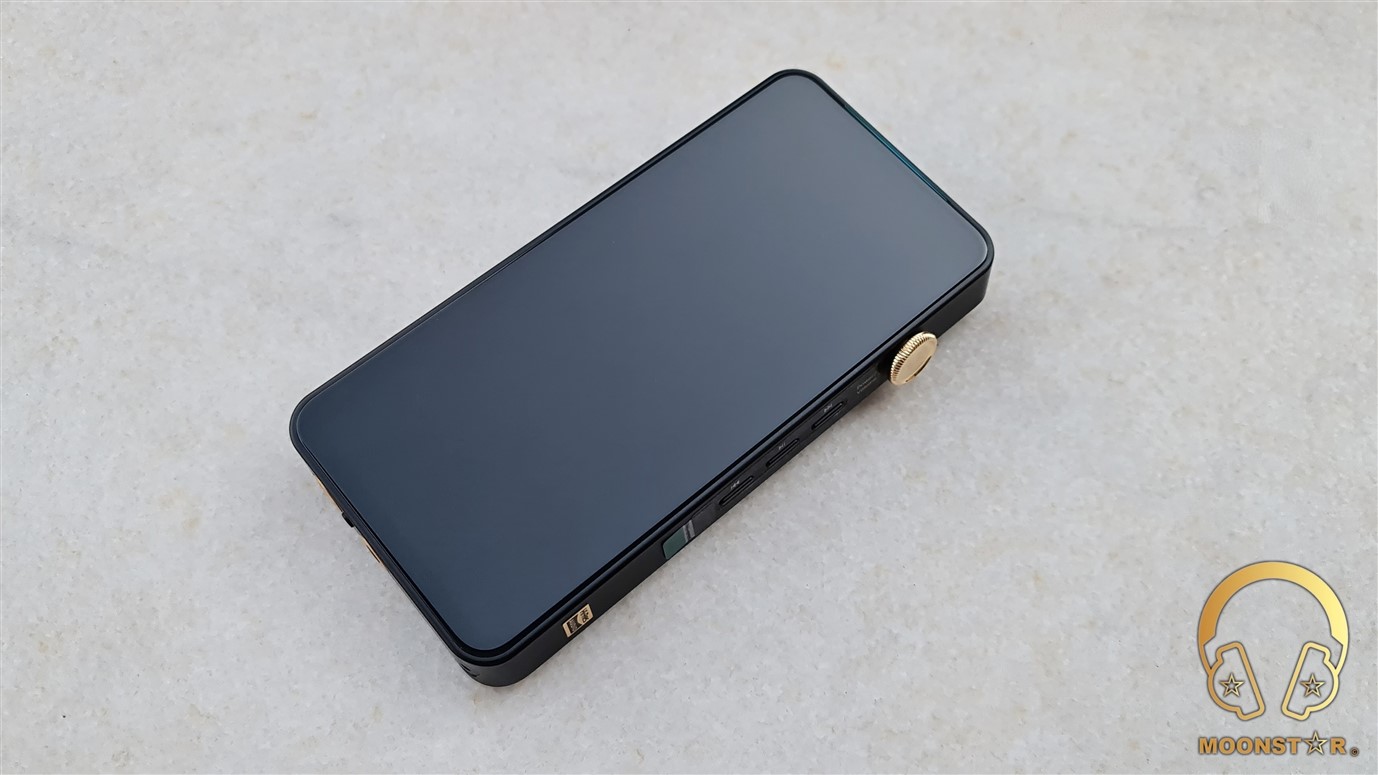

The device has a rectangular shape with rounded edges that reminds the smaller brother DX160.

The main chassis is made of aluminum material that is available in blue and black.

The gorgeous looking 6.5” 2340×1080 screen has a Pixel Density of 397 PPI that you can only find on modern smartphones. It’s a LPTS IPS screen with In-Cell capacitive touch panel that has a 19.5:9 aspect ratio.

There is also an indicator light on the top of the screen, which gives you information about the working status of the device, clear at a glance.

The rear side of the devices sports the iBasso brand logo along with some industrial certifications and the labeling “Reference DAP”. The left and right sides of the rear panel are curved that gives you a better feel of grip.

The surface of the rear panel has a beautiful mat finish that shows an iridescent effect from different angles.

The left side of the DX300 has a single micro SD card slot for storage expansion which will supports at least memory cards up to 2TB (MicroSD Cards in SDHC & SDXC format).

The right side of the device has a slightly angled profile that features the “Multifunctional Control Wheel” in shiny gold color, which works as volume and power control button. It has no protection, which means you need to be extra careful to avoid any possible damage!

Here are also three physical buttons, which are the next/fast forward, play/pause and the previous/rewind buttons.

At the bottom of the iBasso DX300 are the Analog outputs of the AMP11 MK2 amplification module, which is based on the AMP8 amplification module.

Here are the 3.5mm Phone Out/Line Out, the 4.4mm (TRRRS Pantaconn) Balanced Line/Phone Out and 2.5mm (TRRS) Balanced Phone/Line output. This amplification module is fixed with two screws to the devices that you can easily replace.

On the top of the device are the Coaxial Out and the multifunctional USB Type-C port that works as Digital Input, Data Transfer & Charging port.

The device fulfils all of my expectation in terms of build quality from a High End device at this price category “Well done iBasso!”
Technical Specifications:
- Operating System : Android 9.0 / 5th Gen Mango OS
- CPU : 14nm 8 Core Qualcomm Snapdragon 660
- RAM : 6GB LPDDR4X
- ROM : 128 GB
- Screen : 6.5” 2340*1080 IPS – InCell Panel, 397 PPI, 19.5:9 aspect ratio
- DAC : Quad Cirrus Logic CS43198 Chips
- Analog Outputs : 3.5mm PO/LO, 4.4mm & 2.5mm Balance PO/LO
- Digital Out : SPDIF/Coaxial, USB Type-C
- Bluetooth : Bluetooth 5.0
- WiFi : 5GHz WiFi with 2×2 MIMO antenna
- Battery Digital Part : 4000mAh 3.8V Li-Polymer
- Battery Analog Part : 2000mAh 3.8V Li-Polymer
- Battery Life : 14 hours DAP section / 11 – 11.5 hours AMP section
- Charging : Support of QC3.0 and PD2.0 quick charge
- Size : L162MM x W77MM x H17MM
- Weight : 300 grams

Supported Audio and Bluetooth Formats/Codec’s:
The iBasso DX300 supports almost any modern and traditional audio format available on the market including MQA. MQA — short for “Master Quality Authenticated” is a new way to experience high-resolution audio.
MQA encoding folds studio-quality audio into files that are small enough to stream (or store in large quantities on a portable device). But the encoding process doesn’t just make hi-res music files smaller. It makes them sound much better, too.
You can buy a limited selection of MQA downloads now. They play through any equipment that can decode lossless file formats (WAV, FLAC, and ALAC).
List of supported Audio formats is as follows:
- MQA, APE, FLAC, WAV, WMA, AAC, ALAC, AIFF, OGG, MP3, DFF, DSF, DXD
List of supported Bluetooth Codecs:
- LDAC, aptX, AAC, SBC
1.Hardware:
The iBasso DX300 is the most sophisticated device of the DX Series “Digital Audio Player” product line and comes with a long list of impressive hardware features that I will now review in depth for you.
A) DAC (Digital to Analog Converter):
The iBasso DX300 utilizes 4 pieces of Cirrus Logic CS43198 flagship DAC chips to form a DAC array. The DX300 has a total of eight DAC channels with each of the eight having Low Pass Filters with the DAC chips double-paralleled to achieve fully balanced output. Dual DACs in parallel can effectively reduce the discrete distortion caused by a single DAC chip due to the manufacturing process and environmental influences, which greatly improving the sound density and performance.
The measured signal-to-noise ratio is 125dB, the dynamic range is 125dB, and the THD+N is -113dB.

B) USB DAC:
The DX300 is equipped with a high performance USB DAC functionality that do allow you to connect it to a Windows PC, MAC Computer and Linux Computer to stream music. A MAC and Linux device doesn’t need any driver installation, while you need to download and install the USB DAC Driver for your Windows PC under the following link:
Turn the DX300 to the USB DAC mode, connect the DX300 to a computer via the USB-C cable. After the DX300 is detected, the soundcard driver will be installed automatically. Now, you can select the DX300 as the audio output device and use it as the USB soundcard.

C) In-House Developed FPGA-Master:
In the DX300, we adopted an in-house developed FPGA-Master technology. The FPGA-Master, as the audio system controller, directly requests audio data from the SoC, and plays a major role in signal reproduction and maintaining signal integrity. It synchronizes and generates all audio clocks at the same time utilizing two Accusilicon femtosecond oscillators, to achieve a fully synchronized single clock source. The FPGA and oscillators also reduce jitter to an extremely low level, building a clean digital audio signal.
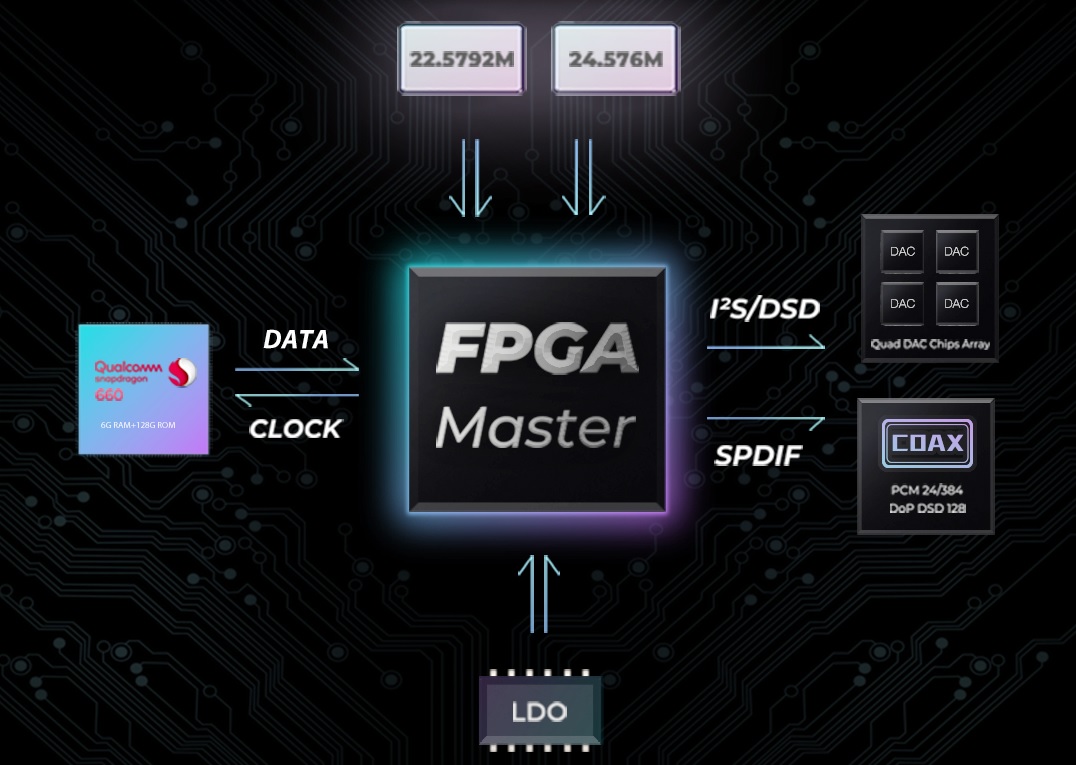
D) CPU/RAM/ROM:
The DX300 is equipped with Qualcomm’s Snapdragon 660 SoC, which still quite powerful thanks to its 14-nanometer 8-core processor. The DX300 comes also with 6GB LPDDR4X RAM and 128GB of onboard storage that will allow you to install various APPs and load your music Library to the device.
You can also expand the storage capacity via Micro SD cards.

E) Wireless Connectivity (WiFi & Bluetooth):
The iBasso DX300 adopts a 5GHz capable antenna with 2×2 MIMO WiFi antenna design, for two input and two output channels, resulting in the data transmission speed and data volume being greatly upgraded.
The DX300 supports Bluetooth 5.0 with an enhanced antenna that gives longer transmission distance and a stronger signal. The DX300 offers also two-way Bluetooth audio transmission and has native LDAC and aptX support, which means that you can send and receive your audio from/to external devices like Headphones/Speakers/Phones/Tablets etc.
F) Replaceable AMP Card & Amplification:
A replaceable AMP Card Design provides for more variety, personalization and enjoyment of your music. With the DX300 patented AMP card design and with the future AMP cards to come, the DX300 provides a wide range possibilities. Longer play time, different output ports, different
Circuit designs, and synergy matching can be achieved with our different cards.
The default AMP card of the DX300 is the AMP11 MK2 that is based on the AMP8’s discrete circuit and is equipped with 3.5mm single ended, 2.5mm balanced and 4.4mm balanced outputs ports (all ports can also be changed to line outputs).
A +/-8V power supply provides sufficient and stable energy for the AMP section. The maximum output current of the transistor reaches 2.7A, which allows the AMP11 to drive IEMs and headphones that require high current with ease.
The maximum voltage output of DX300 reaches 7.1Vrms, and thanks to the independent battery power supply, the maximum output power of 32Ω load is as high as 1240mW, which is quite impressive. The DX300 was able to drive the HiFiMAN Sundara and SIVGA P-II easily to high volume levels.

Some additional output information’s are listed below;
3.5mm Single Ended Output (TRS):
- Maximum Output Level : 3.5Vrms
- Output Power : 350mW@32ohm, 34mW@300ohm
- Frequency Response : 10Hz-40kHz ±0.3dB
- SNR (Signal to Noise Ratio) : 123dB
- Dynamic Range : 123dB
- THD+N : -111dB (no Load, 2Vrms), -107dB (300R Load), -95dB (32R Load)
- Crosstalk : -103dB
- Output Impedance : 0.43ohm
3.5mm Single-ended Line Output:
- Maximum Output Level : 3.5Vrms
- Frequency Response : 10Hz-40kHz ±0.3dB
- SNR (Signal to Noise Ratio) : 123dB
- Dynamic Range : 123dB
- THD+N : -111dB (no Load, 2Vrms)
- Crosstalk : -103dB
4.4mm Balanced (TRRRS) & 2.5mm Balanced (TRRS) Output:
- Maximum Output Level : 7.1Vrms
- Output Power : 1240mW@32ohm, 168mW@300ohm
- Frequency Response : 10Hz-40kHz ±0.3dB
- SNR (Signal to Noise Ratio) : 125dB
- Dynamic Range : 125dB
- THD+N : -113dB (no Load, 3Vrms),-109dB (300R Load) -101dB (32R Load)
- Crosstalk : -120dB
- Output Impedance : 0.39ohm
4.4mm Balanced (TRRRS) & 2.5mm Balanced (TRRS) Line Output:
- Maximum Output Level : 7.1Vrms
- Frequency Response : 10Hz-40kHz ±0.3dB
- SNR (Signal to Noise Ratio) : 125dB
- Dynamic Range : 125dB
- THD+N : -111dB (no Load, 3Vrms)
- Crosstalk : -119dB

Battery Life:
The DX300 comes with iBasso’s Patented Dual Battery Power Supply Structure, which has two independent battery sections same like the DX220 MAX, one for the analog amplifier and one that is dedicated for the digital components such like DAC, CPU, Screen, etc.
The analog part of the device features a 3.8V Li-Polymer with a capacity of 2000mAh, while the Digital section has a 3.8V – Li-Polymer 4400mAh battery.
The Snapdragon 660 CPU shows its efficiency since the DX300 has a slightly smaller battery and a bigger screen that should have normally a lower battery duration compared to the DX220 MAX which has a 4400mAH battery and a screen with a lower resolution.
The battery life of the digital section is about 14 hours at low gain, volume 50 out of 100, Wi-Fi off, screen off, while it offers about 12 hours when you use Streaming services (WiFi on) at the same conditions.

List of Features:
- Quad Cirrus Logic CS43198 DAC Chips are incorporated, with a four-channel balanced headphone amplification circuit.
- Bit for Bit playback with support up to 32bit/384kHz.
- Support of Native DSD up to 256x.
- 5″ IPS full screen (1080*2340), with In-Cell capacitive touch panel.
- Support of QC3.0 and PD2.0 quick charge.
- 2 Accusilicon ultra-low phase noise Femtosecond oscillators.
- USB DAC function that supports up to 32bit/384kHz and DoP DSD128.
- 14nm Octa-Core Qualcomm Snapdragon 660 SoC.
- USB digital output that outputs up to PCM 32bit/384kHz, Native DSD256, and DoP DSD128
- 6GB LPDDR4X + 128GB ROM.
- Mini coaxial output that supports up to 24bit/384kHz and DoP DSD128.
- Support of 5G WiFi with 2×2 MIMO antenna and Bluetooth 5.0.
- Support SDXC and SDHC Micro SD cards.
- Support USB3.1 fast file/data transfer.
Software & GUI (Graphical User Interface):
1. Android:
The DX300 is the fasted device of the “DX Series” thanks to the pretty powerful Qualcomm Snapdragon 660 SoC and the use of 6GB LPDDR4X RAM.
The iBasso DX300 comes with Android OS same like the DX220 MAX, DX220, DX200 & DX150, which is slightly customized by the iBasso software team. The actual Android Version is 9 (Android Pie).
The iBasso DX300 doesn’t comes with some Google Services such like Play Store, Play Music or YouTube. However, iBasso has installed two “Play Store” alternatives, which are CoolApk and APKPure that do have tons of APP’s including popular online streaming services like Spotify, Tidal, Qobuz and many more.
Beside this Market alternatives are some other pre-installed applications like a calculator, Goohle Chrome Browser, clock, file manager, gallery, settings, video and the Mango Music Player shortcut.

The DX300 features the iBasso exclusive “Mango Player Application” that has a nice widget on the home screen of the player. The widget features the album cover, song title, remaining time and buttons like play/pause, previous/rewind & next/fast forward.

The Android OS offers some nice and pretty familiar benefits like the “Top Navigation Bar” for a quick access to your Wi-Fi or Bluetooth connection and Screen Brightness. In addition there are also some helpful shortcuts like Gain, Digital Filter, Phone/Line Output selection, and many more.
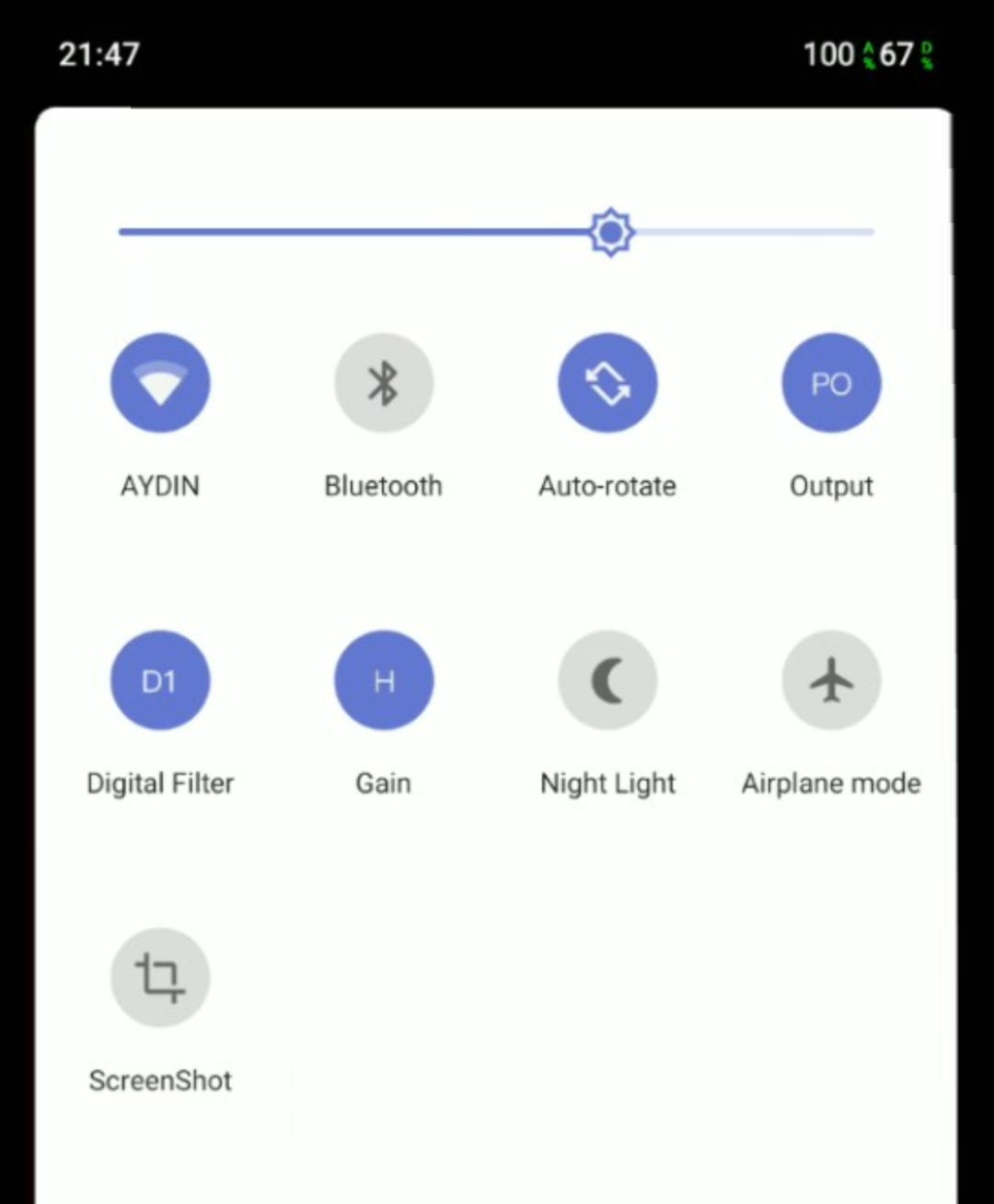
On the left side of the top bar are some icons that do show the actual status of the Volume, Bit Rate and Digital Filter. On the right side of the top bar is the clock, WiFi bar and information about the actual battery status of the Digital and Analog sections.

At the bottom of the home screen are the classical navigation button like the back (triangle), home (circle) and task manager (square).

The settings menu is quite simple and many of us who are using or have used an Android device will feel very familiar with the menus and UI of the settings menu.

The Audio Settings Menu is a nice shortcut that helps you to switch between PO & LO or select the Gain level (Low, Normal, High) and one of the 5 Digital Filters, etc.
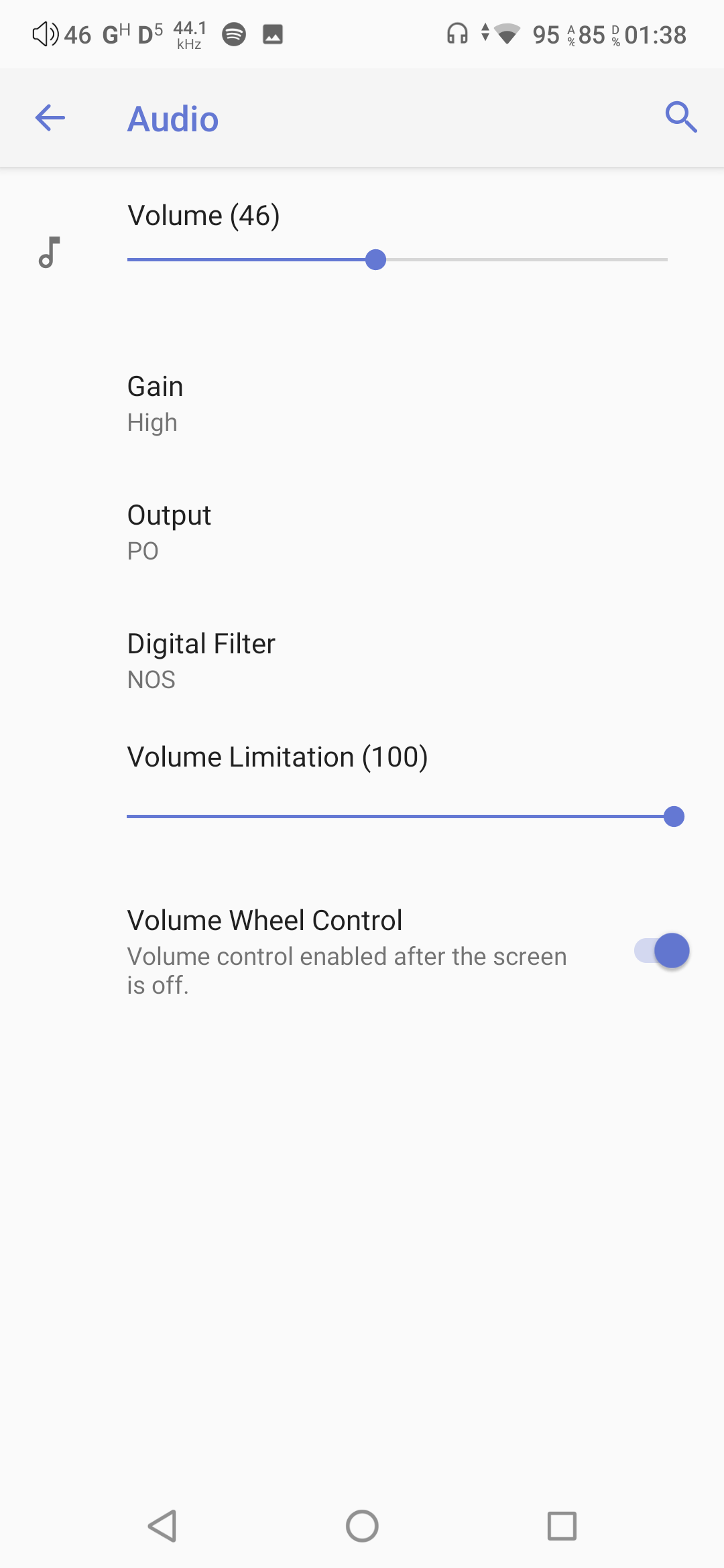
The DX300 comes with the same Dual Boot feature that we have seen on previous devices like the DX220 MAX and DX220. This feature allows you to switch from the Android OS to the Mango OS, which is a iBasso exclusive Linux Operating System.

To switch between Android 9.0 Pie and Mango OS, you need to long press the multifunctional Wheel for about 3 seconds. There is a pop up window with three options where you can select “To Mango”. To return to the Android System, go into the advanced menu of Mango OS and chose Android.
Mango Music Player & Digital Filters:
The Mango Music Player application of the DX300 is the same that was available on the DX220 and DX220 MAX. It has a nice design and some additional features like the section with 5 digital filters and Parametric Equalizer (in short PMEQ) option under the EQ settings menu.
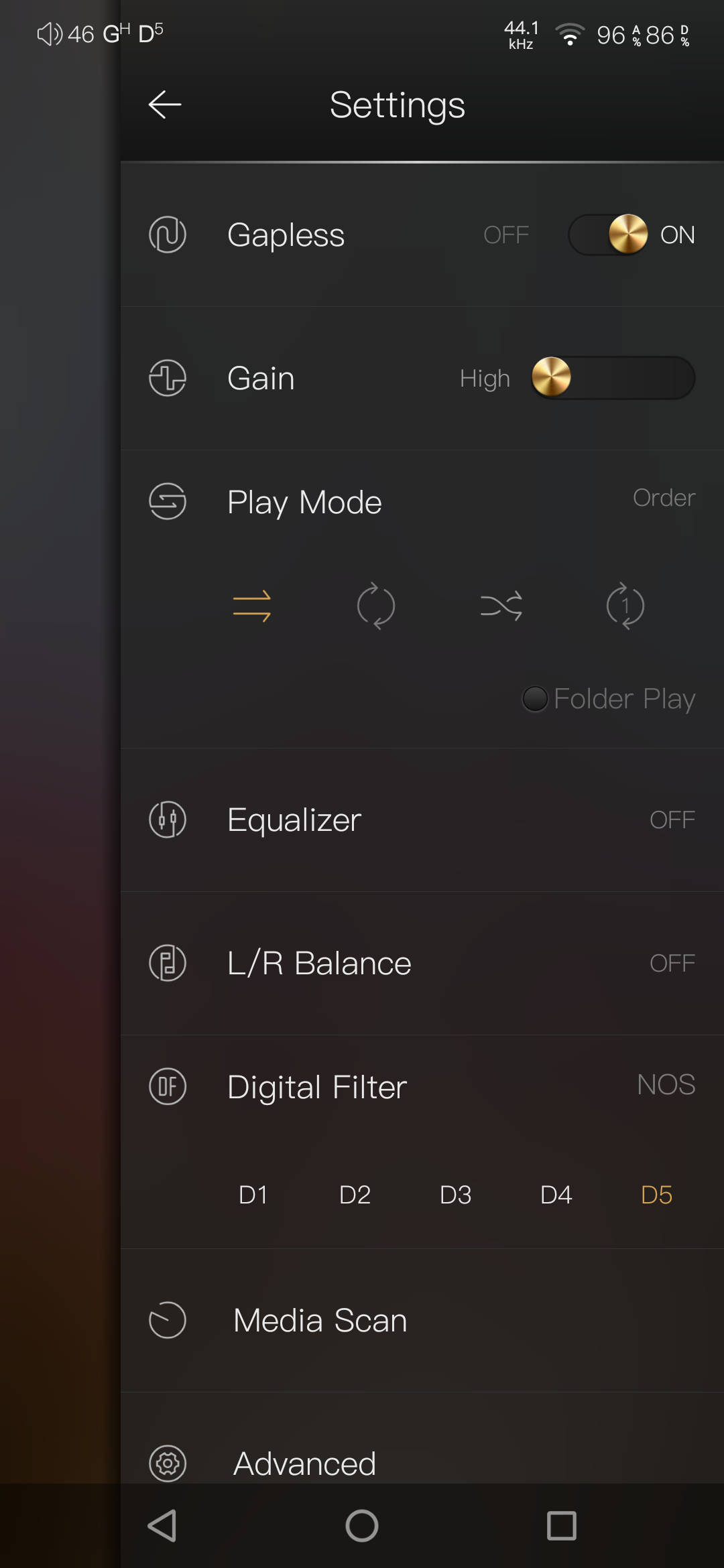
The Digital Filters are listed below;
- D1 – fast roll off
- D2 – short delay, slow roll off
- D3 – short delay, fast roll off
- D4 – slow roll off
- D5 – NOS “No Over Sampling”

2. Mango OS:
The Mango OS is the Linux based Operating System created by iBasso that gives you a “Pure Music Experience”.

Mango OS doesn’t supports Wi-Fi and Third Party applications like Spotify, Tidal, Qobuz, etc.
The user interface of the Mango Music Player is very nice and fast, but it reacts a bit slower than the Mango Music Player application found on the Android operating system.

The 10 band EQ that can be found on Android OS remains while you lose the beautiful PMEQ (Parametric Equalizer) which is the only negative about then Mango OS.

Equipment’s used for this review:
- DAP’s : iBasso DX300, iBasso DX220 MAX, iBasso DX220
- IEM’s : iBasso IT07, Campfire Audio ARA, Meze Rai Penta, Metalure WAVE
- Headphones : iBasso SR2, HiFiMAN Sundara, SIVGA P-II
Albums & tracks used for this review:
- Schiller – Love “by Rebeca Ferguson” (Spotify)
- Bro Safari, UFO! – Drama (Deezer HiFi)
- Really Slow Motion – Deadwood (Deezer HiFi)
- Lorde – Royal (Flac 24bit/48kHz)
- Toutant – Rebirth (Deezer HiFi)
- Tom Player – Resonace Theory “Album” (Deezer HiFi)
- Photek – The Hidden Camera (Spotify)
- Sarah McLachlan – Angel (Flac 24bit/48kHz)
- Dionne Warwick – Walk on By (Flac 24bit/96kHz)
- Edith Piaf – Non Je Ne Regrette Rien (Flac 16bit/44.1kHz)
- Aretha Franklin – I Say a Little Prayer (Flac 24bit/96kHz)
- Diana Krall – So Wonderful (DSF)
- First Aid Kit – My Silver Lining (Flac 16bit/44.1kHz)
- Sertap Erener – Aşk (Flac 16bit/44.1kHz)
- Barry White – Just The Way You Are (Flac 24bit/48kHz)
- Isaac Hayes – Walk On By (Flac 16bit/44.1kHz)
- Sting – Englishman in New York – (Flac 24bit/48kHz)
- Eric Clapton – Wonderful Tonight (Flac 24bit/96kHz)
- Elton John – Rocket Man (Deezer HiFi)
- B.B. King – Riding With The King (Flac 24bit/96kHz)
- U2 – Sunday Bloody Sunday (Flac 16bit/44.1kHz)
- Charly Antolini – Duwadjuwandadu (Flac 24bit/192kHz)
- Chopin – Nocturn No. 20 In C-Sharp Minor (Flac 16bit/44.1kHz)
- Fazıl Say – Nazım Oratoryosu (Live) (Flac 16bit/44.1kHz)
- Vivaldi – Le QuarttroStagioni “The Four Season” (Deezer HiFi)
- Otto Liebert& Luna Negra – The River (Flac 24bit/192kHz)
- Armin Van Buuren – Vini Vici (Flac 16bit/44.1kHz)
- No Doubt – Hella Gut (Flac 16bit/44.1kHz)
- Haken – Prosthetic (Flac 16bit/44.1kHz)
- Lunatic Soul – The Passage (Flac 16bit/44.1kHz)
- Metallica – Sad but True (Flac 24bit/96kHz)
- Opeth – Windowpane (Flac 16bit/44.1kHz)
- Megadeth – Sweating Bullets (Tidal Hi-Fi)
- Rush’s – Leave That Thing Alone (Flac 16bit/44.1kHz)
- Slayer – Angel of Death (Spotify)s
- Liquid Tension Experiment 2 – Acid Rain (Spotify)
- Yosi Horikawa – Bubbles (Spotify)

The Sound Performance:
The DX300 is the latest Portable flagship DAP of the company that immediately impressed me with its “Top of the Line” sound performance that I have heard with IEMs like the iBasso IT07, Campfire Audio ARA, Meze Rai Penta, Metalure WAVE and headphone like the iBasso SR2 and SIVGA P-II.
What you will hear is an impressive sense of space and staging that is the common features of iBasso DAP’s since the DX200 (even the DX90). The DX300 delivers a dynamic, natural yet musical sound experience with high level of micro detail and technicality, while it adds just the right amount of coloration to fulfill the description “Reference Digital Audio Player”.
The DX300 has a slightly warmer tonality than the DX220 MAX, while it sounds more neutral compared to the DX150, which has the warmest tonality of the DX series. When it comes to the frequency response, the bass is nicely layered, shows a great sense of depth and dynamism, the midrange on the other hand is highly detailed, transparent and musical, while the treble area has a good level of extension, control and sense of airiness.
Please note that my sound analyses for the DX300 are written after a burn-in of about 150 hours and are mainly based on my sound experiences over the 4.4mm (TRRRS) Balanced output. I have used the “D3 digital Filter” and Headphones such like the iBasso SR2 & SIVGA P-II and some TOTL IEM’s like the iBasso IT07, Campfire Audio ARA and Meze Rai.

Bass:
The DX300 shows a pretty natural, clear/transparent and detailed bass response from the subbass up to the midbass area, moreover it offers also a good sense of control and extension with the IEMs/Headphones I have listen with it.
The subbass region of the iBasso DX300 has a warmish tonality and shows a pretty energetic yet controlled response. This area sounds detailed and shows a good sense of extension when I do listen to instruments like a bass guitar, drums or violas.
The DX300 has shown an impressive synergy with almost any IEM or Headphone that I have listen, especially IEM’s like the iBasso IT07, Meze RAI Penta & Metalure WAVE or headphones like the iBasso SR2 were able to produce a solid subbass performance. The DX300 is able to produce a good sense of subbass intensity and powerful rumble that was extremely satisfying with songs like Massive Attack’s “Angel”, “Toutant’s “Rebirth” and Lorde’s “Royals.
The iBasso DX300 offers a natural, punchy and tight midbass response with good level of detail retrieval and extension. Instruments like cross drums and trumpets are nicely accented and do show a warmish and sweet tonality. The midbass of the DX300 sounds controlled and offers a good sense of decay, without to show remarkable negative conditions like a midbasss hump, muddiness and mixings, when I do listen to percussion instruments such like kick or snare drums in complex passages.
For example, drum intros in Opeth’s “Windowpane” or U2’s “Sunday Bloody Sunday” do sound full bodied and are represented with a good level of speed and detail retrieval that I have very enjoyed.
The overall bass performance of the DX300 can be defined as very transparent, highly technical and detailed with good sense of separation and control that fulfills my expectation from a Top of the Line Digital Audio Player.

Midrange:
The midrange of the iBasso DX300 shows a nicely tuned, mildly warm tonality and quite natural timbre with great sense of clarity and resolution from the lower midrange up to the upper midrange area. Moreover, the DX300 offers a very musical, highly transparent and detailed presentation when I do listen to instruments or to male and female vocals.
Vocals & Instruments:
The lower midrange of the iBasso DX300 offers a good level of depth and intensity. Male vocals do have a slightly warmer than neutral tonality and do sound very emotional when I do listen to the DX300 with the iBasso IT07, Mezze RAI Penta or Metalure WAVE. The upper midrange sounds nicely emphasized and adds the overall presentation a good sense of transparency and resolution when I do listen to female voices.
The success of the female vocals in terms of extension, control and clarity is far above average. It is possible to hear and to follow the changes in emotions such as sadness, joy and softness of the male and female voices that is outstanding, form Edith Piaf to Dionne Warwick, from Sting to Barry White.
When it comes to the instrument presentation of the iBasso DX300, I can say that it offers a mildly warm (slighty warmer than the DX220 MAX), musical and highly detailed presentation. Instruments such as pianos are soft yet lively, while guitars are warmish, transparent and do have nice hint of brightness towards the highs. For example the guitar performance in “Eric Clapton’s – Unplugged Album” was epic, especially with the iBasso IT07 and Campfire Audio ARA.
Instruments do not play too much close to each other, which shows that the DX300 is a DAP with a very balanced and controlled presentation. Moreover, I can say that it offers an above average performance in terms of separation and placement of instruments and vocals, which fulfils my expectations from a portable Digital Audio Player at this level.

Upper Midrange and Treble:
The upper midrange of the iBasso DX300 is detailed, soft and offers a good sense of extension. This area sounds a bit smoother and relaxed compared to the DX220 while I really enjoy the natural and transparent timbre.
The upper midrange transitions are very controlled and don’t show any unwanted over sharpness or harshness when instruments like electro guitars do play with high level of distortion. This tuning makes the DX300 ideal for long listening periods without to give compromises in terms of resolution and naturalness. Other instruments such as violins are slightly bright and do show a good level of extension, while pianos do sound nicely pronounced and lively.
The iBasso DX300 has a well-tuned treble character with a somewhat warmish but nicely bright tonality. Instruments like Hi-hats in metal music have a good level of intensity and it is very easy to count any hits. Crash and ride cymbals on the other hand do sound pretty fast and controlled, when I do listen the DX300 with IEM’s like the iBasso IT07, Campfire Audio ARA or Headphones like the SIVGA P-II and iBasso SR2.
Other instruments such like pianos in Jazz Music do sound clear and distinct, with good amount of airiness and sense of clarity. Violins and wood winds in classical music doesn’t have any mixing or sharpness, while flutes or clarinets do sound crisp, clear and with good level of treble extension.

Soundstage and Background:
The iBasso DX300 is a very capable High End DAP in terms of separation and placement of instruments and the vocals. It offers a very spacious and airy soundstage atmosphere and shows a quite impressive holographic presentation with good sense of width and depth.
The DX300 has the darkest and one of the most silent backgrounds of the DX Series Audio Players and offers a better performance compared to the DX220 with the AM1 MKII amplifier module. I did not hear any noise from my very sensitive IEM’s, which will allow me to focus on the smallest micro-details during critical listening periods.
Some Comparisons:

iBasso DX300 versus iBasso DX220 (with AMP1 MKII):
The DX300 comes with some major improvements such like a bigger screen with higher resolution, a faster processor (snappier UI) and more RAM, higher capacity battery (more battery life), and offers also a stock amplifier card with more output options and driving power compared to the DX220.
The DX300 shows a slightly warmer tonality compared to the DX220 with AMP1 MKII amplifier module along with a blacker background. The subbass region of the DX300 shows a tad more authority and detail retrieval, while the depth and intensity is pretty close. The midbass region of the DX300 has a bit more body and resolution, however the DX220 is head to head with the DX300 in terms of resolution and control in this area.

The midrange of both the DX300 and DX220 sounds outstanding in terms of clarity, resolution and overall timbre. The main difference is that the DX300 shows a slightly warmer tonality and smoother presentation compared to the DX220, which sounds a bit more sterile and bright. The differences are minimal but audible with many songs.
The upper midrange of the DX220 sounds a tad brighter, while the DX300 sounds a bit smoother and has the slightly edge in terms of control in this area. The treble range of the DX300 shows slightly more authority, while both devices do have a good sense of detail retrieval and extension.
Both the DX300 and DX220 do have an impressive performance in terms separation and placement of instruments and vocals. The DX220 is pretty close to the DX300 when it comes to the soundstage depth and wideness, however the DX300 has a minor advantage in terms of wideness of the stage, while listen to Yosi Horikawa’s “Bubbles”.
iBasso DX300 versus iBasso DX220 MAX:
Both devices do have a bigger size compared to past products like the DX220, DX200, and DX150, especially compared to the DX160, which is the smallest member with Android OS. However, the DX300 is maybe taller but still more portable (slimmer and lighter) compared to the DX220 MAX, which is a transportable device and a direct rival to the Sony DMP-Z1.
The DX220 MAX has a darker background, slightly warmer tonality, and shows a fuller and smoother presentation compared to the DX300, however the difference is not on a night and day level.
The subbass region of the DX220 MAX shows more depth, rumble and intensity compared to the DX300, while both are on par when it comes to the detail retrial and control in this area. The midbass of the DX220 MAX shows a slightly better sense of dynamism, authority and is also more impactful in certain songs with that I have listen to it.
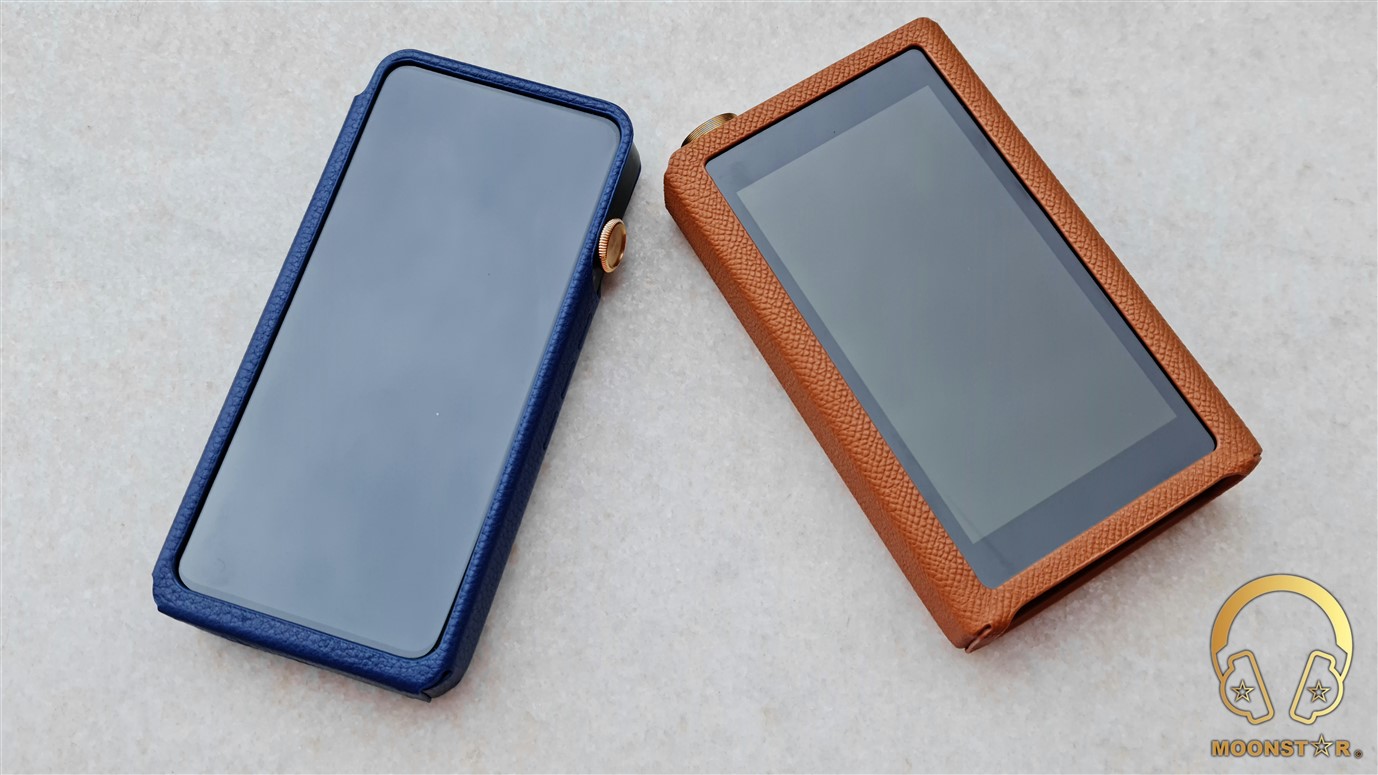
The midrange of the DX220 MAX shows slightly more micro detail and dynamism compared to the DX300, which offers otherwise a “Top of the Line” experience in this area. The upper midrange of the DX300 shows a smoother character.
The treble range of both devices has good sense of airiness and sparkle with top level of extension. The treble area of the DX300 is a tad more upfront and vivid compared to the DX220 MAX that shows a slightly smoother character with impressive sense of resolution.
When it comes to the soundstage I can say that both DAP’s do have an outstanding performance. The main difference is that the DX220 MAX has the upper hand in terms of soundstage wideness, while the depth is on par with the DX300.

Conclusion:
iBasso has listen to its customers (me too) and has analyzed the Portable Audio Player market very well. The final result is a great looking device with “Top of the Line” sound performance and hardware features, which comes with a gorgeous high resolution screen, a fast Processor + 6GB of RAM for a fluid experience.
But that’s not all, it offers also a decent Battery life, Powerful Stock AMP module that it very silent and equipped with various outputs options, moreover it has a pretty fast Wireless connectivity for Online Music Services. All this features making the DX300 to an impressive, future-proof Reference Digital Audio Player.
Pros and Cons:
- + Impressive Sound Performance from the Top to the Bottom
- + Overall Detail Retrieval, Technicality & Musicality
- + Fast & Power Efficient SoC
- + Fluid & Lack free GUI
- + Great Looking High Resolution Screen
- + Solid Battery Life
- + Rich Set of Accessories (Leather Case, Cables/Adaptors, Screen Protectors, etc.)
- – Multifunctional Control Wheel has no Protection
- – The Protective Case Restricts the Operation of the Control Wheel
- – The device feels quite ergonomic in your hands but is a bit tall compared to the DX220
Thank you for the Read!

